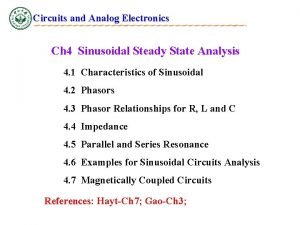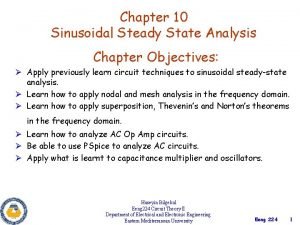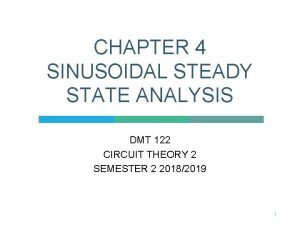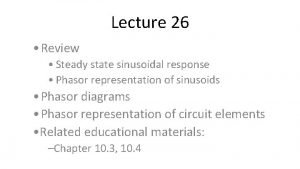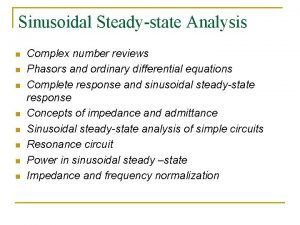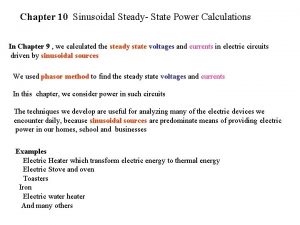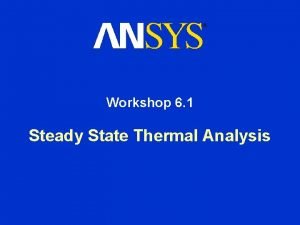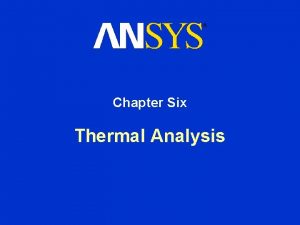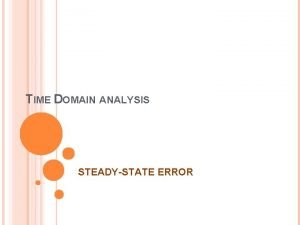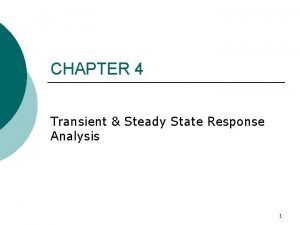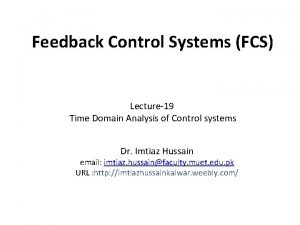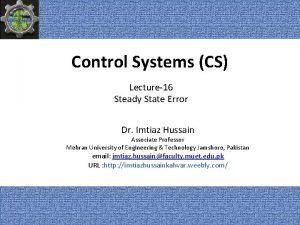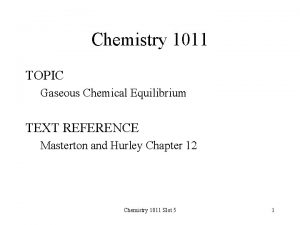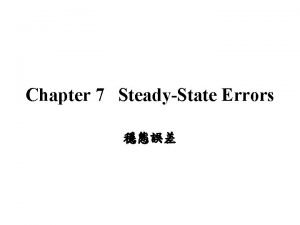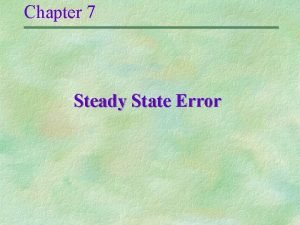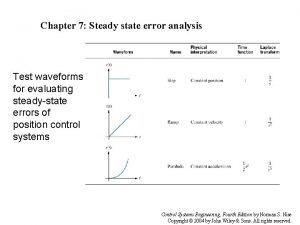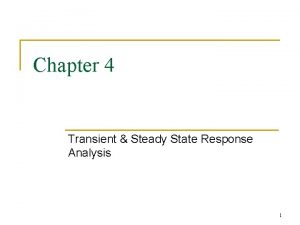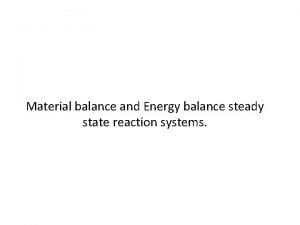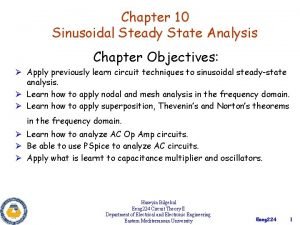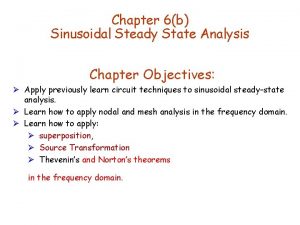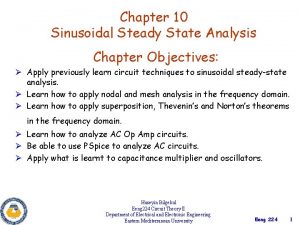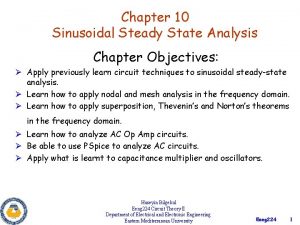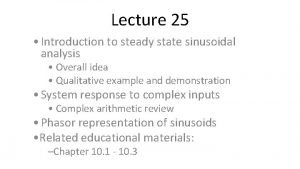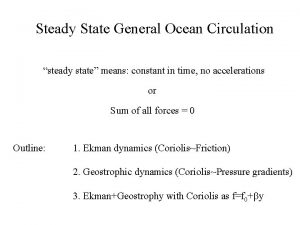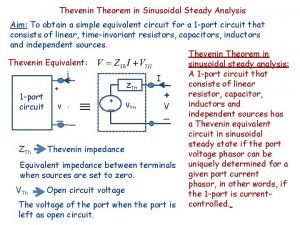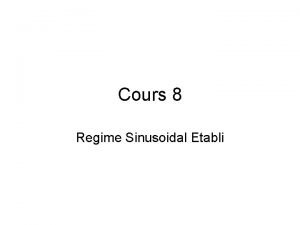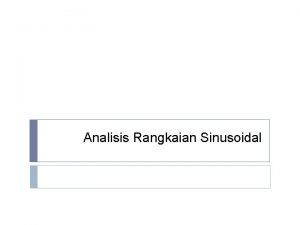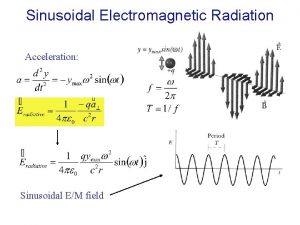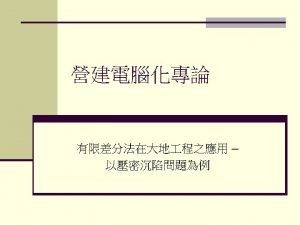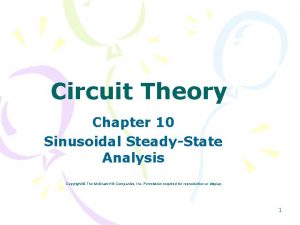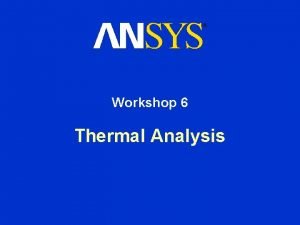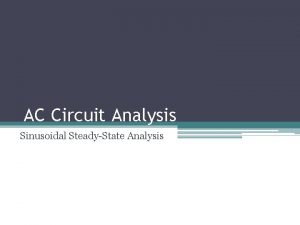Chapter 10 Sinusoidal Steady State Analysis 1 Copyright

























- Slides: 25

Chapter 10 Sinusoidal Steady. State Analysis 1 Copyright © 2013 The Mc. Graw-Hill Companies, Inc. Permission required for reproduction or display.

Sinusoids: Defining Terms the amplitude of the wave is Vm the argument is ωt the radian or angular frequency note that sin() is periodic is ω Copyright © 2013 The Mc. Graw-Hill Companies, Inc. Permission required for reproduction or display. 2

Period of Sine Wave the period of the wave is T frequency f is 1/T: units Hertz (Hz) Copyright © 2013 The Mc. Graw-Hill Companies, Inc. Permission required for reproduction or display. 3

Sine Wave Phase A more general form of a sine wave includes a phase θ The new wave (in red) is said to lead the original (in green) by θ. The original sin(ωt) is said to lag the new wave by θ. θ can be in degrees or radians, but the argument of sin() is always radians. Copyright © 2013 The Mc. Graw-Hill Companies, Inc. Permission required for reproduction or display. 4

Forced Response to Sine Sources When the source is sinusoidal, we often ignore the transient/natural response and consider only the forced or “steady-state” response. The source is assumed to exist forever: −∞<t<∞ Copyright © 2013 The Mc. Graw-Hill Companies, Inc. Permission required for reproduction or display. 5

Finding the Steady-State Response 1. Apply KVL: 2. Make a good guess: 3. Solve for the constants: Copyright © 2013 The Mc. Graw-Hill Companies, Inc. Permission required for reproduction or display. 6

The Complex Forcing Function Apply superposition and use Copyright © 2013 The Mc. Graw-Hill Companies, Inc. Permission required for reproduction or display. 7

The Steady-State Response via Complex Forcing Function 1. Apply KVL, assume vs=Vmejωt. 2. Find the complex response i(t) = Imejωt+θ 3. Find Im and θ, (discard the imaginary part) Copyright © 2013 The Mc. Graw-Hill Companies, Inc. Permission required for reproduction or display. 8

Example: Sine Wave Analysis Find the voltage on the capacitor. Answer: vc(t)=298. 5 cos(5 t − 84. 3◦) m. V Copyright © 2013 The Mc. Graw-Hill Companies, Inc. Permission required for reproduction or display. 9

The Phasor The term ejωt is common to all voltages and currents and can be ignored in all intermediate steps, leading to the phasor: The phasor representation of a current (or voltage) is in the frequency domain Copyright © 2013 The Mc. Graw-Hill Companies, Inc. Permission required for reproduction or display. 10

Phasors: The Resistor In the frequency domain, Ohm’s Law takes the same form: Copyright © 2013 The Mc. Graw-Hill Companies, Inc. Permission required for reproduction or display. 11

Phasors: The Inductor Differentiation in time becomes multiplication in phasor form: (calculus becomes algebra!) Copyright © 2013 The Mc. Graw-Hill Companies, Inc. Permission required for reproduction or display. 12

Phasors: The Capacitor Differentiation in time becomes multiplication in phasor form: (calculus becomes algebra!) Copyright © 2013 The Mc. Graw-Hill Companies, Inc. Permission required for reproduction or display. 13

Summary: Phasor Voltage/Current Relationships Time Domain Frequency Domain Calculus (hard but real) Algebra (easy but complex) Copyright © 2013 The Mc. Graw-Hill Companies, Inc. Permission required for reproduction or display. 14

Kirchhoff’s Laws for Phasors Applying KVL in time implies KVL for phasors: Applying KCL in time implies KCL for phasors: Copyright © 2013 The Mc. Graw-Hill Companies, Inc. Permission required for reproduction or display. 15

Impedance Define impedance as Z=V/I, i. e. V=IZ ZR=R ZL=jωL ZC=1/jωC Impedance is the equivalent of resistance in the frequency domain. Impedance is a complex number (unit ohm). Impedances in series or parallel can be combined using “resistor rules. ” Copyright © 2013 The Mc. Graw-Hill Companies, Inc. Permission required for reproduction or display. 16

Impedance Relationships the admittance is Y=1/Z YR=1/R YL=1/jωL YC=jωC if Z=R+j. X; R is the resistance, X is the reactance (unit ohm Ω) if Y=G+j. B; G is the conductance, B is the susceptance: (unit siemen S) Copyright © 2013 The Mc. Graw-Hill Companies, Inc. Permission required for reproduction or display. 17

Example: Equivalent Impedance Find the impedance of the network at 5 rad/s. Answer: 4. 255 + j 4. 929 Ω Copyright © 2013 The Mc. Graw-Hill Companies, Inc. Permission required for reproduction or display. 18

Nodal and Mesh Analysis Find the phasor voltages V 1 and V 2. Answer: V 1=1 -j 2 V and V 2=-2+j 4 V Copyright © 2013 The Mc. Graw-Hill Companies, Inc. Permission required for reproduction or display. 19

Nodal and Mesh Analysis Find the currents i 1(t) and i 2(t). Answer: i 1(t) = 1. 24 cos(103 t + 29. 7◦) A i 2(t) = 2. 77 cos(103 t + 56. 3◦) A Copyright © 2013 The Mc. Graw-Hill Companies, Inc. Permission required for reproduction or display. 20

Superposition Example The superposition principle applies to phasors; use it to find V 1. Answer: V 1=V 1 L +V 1 R =(2 -j 2)+(-1) = 1 -j 2 V Copyright © 2013 The Mc. Graw-Hill Companies, Inc. Permission required for reproduction or display. 21

Thévenin Example Thévenin’s theorem also applies to phasors; we can use it to find V 1. The setup is shown below: Copyright © 2013 The Mc. Graw-Hill Companies, Inc. Permission required for reproduction or display. 22

Phasor Diagrams The arrow for the phasor V on the phasor diagram is a photograph, taken at ωt = 0, of a rotating arrow whose projection on the real axis is the instantaneous voltage v(t). Copyright © 2013 The Mc. Graw-Hill Companies, Inc. Permission required for reproduction or display. 23

Example Phasor Diagram If we assume I=1 ⁄ 0° A Copyright © 2013 The Mc. Graw-Hill Companies, Inc. Permission required for reproduction or display. 24

Phasor Diagram: Parallel RLC Assume V = 1 /0◦ V Copyright © 2013 The Mc. Graw-Hill Companies, Inc. Permission required for reproduction or display. 25
 Complex impedances
Complex impedances Sinusoidal steady state analysis solved problems
Sinusoidal steady state analysis solved problems Sinusoidal steady state analysis
Sinusoidal steady state analysis Steady state sinusoidal analysis using phasors
Steady state sinusoidal analysis using phasors Sinusoidal steady state
Sinusoidal steady state Steady state current formula
Steady state current formula Partogram interpretation
Partogram interpretation What is steady-state thermal analysis?
What is steady-state thermal analysis? What is steady-state thermal analysis?
What is steady-state thermal analysis? Steady state error
Steady state error Steady state response formula
Steady state response formula Contoh pengangguran alamiah
Contoh pengangguran alamiah Mitokondre
Mitokondre Nicole menten
Nicole menten Steady flow process thermodynamics
Steady flow process thermodynamics Steady state response in control system
Steady state response in control system In a normal operations/steady state eoc activation level
In a normal operations/steady state eoc activation level Steady state error from bode plot
Steady state error from bode plot Steady state vs equilibrium
Steady state vs equilibrium Michaelis menten steady state
Michaelis menten steady state Steady-state error
Steady-state error Steady state error of closed loop system
Steady state error of closed loop system Steady state error table
Steady state error table Hurtwitz
Hurtwitz Material balance definition
Material balance definition Schilthuis steady state model
Schilthuis steady state model
